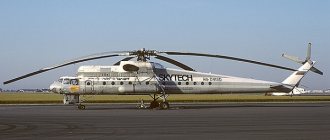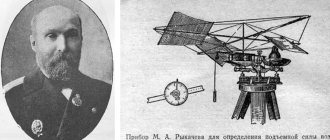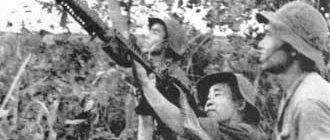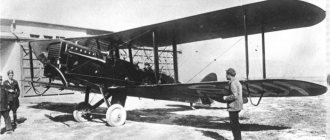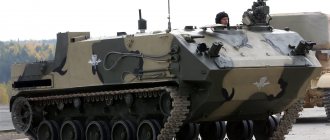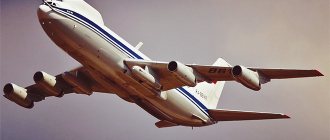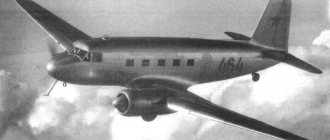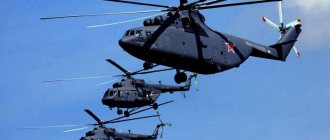The first one is hard
The history of the creation of the Yak-24 began in the summer of 1951 at a meeting in the Kremlin, in which, in addition to the future recognized helicopter pilots Mil and Kamov, equally famous aircraft designers Tupolev, Ilyushin and Yakovlev participated. All of them were tasked with quickly overcoming the gap between our country and the United States in the field of heavy helicopter manufacturing. This lag became noticeable after the widespread use of helicopters by American troops in a number of wars that the United States was waging at that time in Southeast Asian countries.
Then, marines were landed from helicopters in almost any area inaccessible to conventional transport, an air supply of ammunition and weapons was organized, and the removal of the wounded was ensured. There were no such helicopters in the USSR. Therefore, the need arose to create a large landing transport helicopter.
Links
Stormtroopers: Yak-38 Yak-38M Bombers: Yak-2 · Yak-4 · Yak-26 · Yak-28 Transport aircraft: Yak-6 Yak-8 Special aircraft: Yak-44 Passenger aircraft: Yak-40 Yak-42 Yak-142 Yak-242 MS-21
Training and sports aircraft: UT-1 UT-2 UTI-26 (Yak-7UTI) Yak-11 Yak-18 Yak-18T Yak-21T Yak-30 (1960) Yak-32 Yak-38U Yak- 50 · Yak-52 · Yak-54 · Yak-55 · Yak-130 · Yak-152 Multi-role aircraft: Yak-12 · Yak-48 · Yak-58 · Yak-112 Gliders: Yak-14 Experimental aircraft, helicopters and projects: AIR Yak-19 Yak-25 (1947) I-26 I-30 Yak-30 (1948) Yak-35 Yak-36 Yak-39 Yak-50 (1949) Yak-43 · Yak-201 · Albatross · GDP-6 · Yak-7R · V-38 Helicopters: · Yak-24 · Yak-60 · Yak-100 Unmanned: Shmel-1 · Bee-1T · Lark-1 · Lark-2 · Proryv · Yak-133BR
Two competitors
Tupolev and Ilyushin flatly abandoned this project, citing the heavy workload of their design bureaus and a complete lack of experience in helicopter design. At that time, such a step was, if not a feat, then an act that required considerable courage.
Kamov did not design large helicopters at that time. Therefore, the implementation of an important government task was entrusted to Yakovlev and Mil. The first had experience in the design and construction of experimental rotorcraft: in 1945, a two-seat helicopter with coaxial rotors was already created, and in 1950, a single-rotor Yak-100 with a three-bladed tail rotor.
Another and probably the most important reason for A. Yakovlev’s participation in the competition was that he could not help but agree to participate in it, because according to eyewitnesses, the unforgettable Lavrenty Pavlovich Beria threateningly told the designer: “Either you will make a helicopter or nothing, I understand.” ?.
Mil was entrusted with the development of a single-engine helicopter for 12 paratroopers. By that time he had considerable experience in the construction of rotorcraft. OKB Mi-1 and Mi-2 helicopters have already flown successfully. Looking ahead, we can say that the project of a 12-seater helicopter was implemented and it, under the Mi-4 brand, became widespread in our country and abroad.
Helicopter Yakovlev Yak-24
The Yak-24 helicopter was designed in an extremely short period of time: 9 months passed from the start of the preliminary design (October 1951) to the first flight (July 1952).
This is despite the fact that the Pyasetsky N-16, similar in design, was built for 7 years, from 1946 to 1953. In the USSR, experimental work on the creation of helicopters has been carried out since the early 30s. Various design teams created original models of rotorcraft. They made test flights, in some cases demonstrating good performance, but in general they were very imperfect and unsuitable for practical use. By the early 50s, the USSR's lagging behind other states in the helicopter industry did not suit the country's leadership. The situation was aggravated by the fact that the United States and NATO countries widely used helicopters for military purposes. During the war on the Korean Peninsula, helicopters that were in service with the American army were used. Helicopters, landing on small plots of land and taking off from them, hovering in the air, in the plans of the military were obliged to compensate for the inherent shortcomings of aircraft.
Stalin, having learned about the large-scale use of rotary-wing aircraft by the armies of a potential enemy, turned to leading aircraft manufacturers. During the debate, two design bureaus received the design task: Mil OKB and Yakovlev OKB.
The device changed several names at the design, development and production stages. The latter sounded like “product Ш”. For this experimental device, the designers chose an original twin-screw coaxial design. No one had any experience in designing such machines. A developed theory of coaxial propeller mechanics did not even exist. Everything had to start from scratch. The design of the helicopter was repeatedly redesigned. The tail was installed and then removed. Two years later, without achieving serious results, the project was canceled.
In February 1948, they began creating the Yak-100 helicopter. It was made according to the classic single-screw design. After 2 years, the car successfully passed state tests. However, the Mi-1 helicopter from the M. Mil design bureau was put into serial production and showed higher flight characteristics. After a meeting in the Kremlin on September 24, 1951, the Yakovlev Design Bureau began work on a transport and landing helicopter with flight data that was unique at that time and a payload capacity of 4 tons.
The designers abandoned the classical design and began to design an apparatus with two rotors located longitudinally along the axis of the fuselage. Such machines had not been built before in the Soviet Union or even experimental models had been developed. The project received the designation Yak-24. 2 weeks later, on October 5, 195, a resolution of the Council of Ministers was issued, in which Mil Design Bureau was also instructed to create a single-propeller Mi-4. The government required that the main components and assemblies of new helicopters: rotors, engines, gearboxes, control systems - be interchangeable or identical.
The development was carried out on the basis of broad cooperation with the involvement of several research organizations, including the Zhukovsky Central Aerohydrodynamic Institute, the Central Institute of Aviation Materials and the All-Union Institute of Aviation Engineering. The design bureaus carried out the development of the main units and their layout on both devices together. Good coordination allowed us to complete the design work in the shortest possible time.
On July 3, 1952, the first ten-minute test flight took place. Pilots noted increased vibration levels and vertical “shaking.” The consequence of this was the discovery of defects related to the strength of the structure - cracks and destruction of individual components appeared. After shortening the rotors by 500 mm, “shaking” as such was not observed. The Yak-24 became the first twin-rotor helicopter in the Soviet Union, which was based on a longitudinal rotor layout. And in the period 1953-1957 - the largest apparatus of this class in the world. It had the highest payload and engine power in the world.
The high flight characteristics of the Yak-24 were confirmed in December 1955, when 2 world records for carrying capacity were set on it. The flight behavior of the vehicle was stable, the engines worked reliably. In terms of piloting technique, the Yak-24 turned out to be accessible to any pilot of average qualification. In 1955, the helicopter was adopted by the Soviet Air Force. It could accommodate military equipment and 19 paratroopers with full equipment. The helicopter was also used in the national economy.
In 1959, Yak-24 helicopters took part in large-scale exercises of the Warsaw Pact countries in the Kyiv area and on the territory of the GDR. During the exercises, Yak-24 helicopters performed flights along the route Moscow - Berlin and Moscow - Kyiv.
In addition to the military, there were also civilian modifications of the helicopter: “flying crane”, “comfortable passenger airliner”. In total, about one hundred vehicles of this type were produced during mass production. Over the decade of operation, the helicopter has never crashed causing loss of life.
Flying carriage
Alexander Yakovlev chose the design of a twin-engine, twin-rotor helicopter with a longitudinal propeller arrangement along the axis.
The choice of longitudinal design made it possible to fully use the entire volume of the fuselage to accommodate power plants, troops or cargo.
Only one year was allotted for the design, construction and testing of the helicopter, designated Yak-24. But when creating the machine, it was necessary to solve a lot of issues that aircraft manufacturers had never faced closely: cooling engines operating in helicopter hovering mode, eliminating vibration of the fuselage and propellers.
In order to meet the deadlines, the design bureau began to build 4 copies of the Yak-24 helicopter at once, intended to test static strength on a test bench, dynamic strength when the engines are running on the ground (tethered), for flight factory and state tests.
Yak-24 characteristics:
| Modification | Yak-24 |
| Main screw diameter, m | 2 x 20.2 |
| Length, m | 21.34 |
| Weight, kg | |
| empty | 10607 |
| normal takeoff | 14270 |
| maximum takeoff | 16800 |
| engine's type | 2 PD Shvetsov ASh-82V |
| power, kWt | 2 x 1268 |
| Maximum speed, km/h | 173 |
| Cruising speed, km/h | 150 |
| Ferry range, km | 1300 |
| Practical range, km | 650 |
| Range with maximum load, km | 255 |
| Practical ceiling, m | 5000 |
| Static ceiling, m | 2700 |
| Crew, people | 3 |
| Payload: | 30 soldiers or 18 stretchers or 4000 kg of cargo |
Helicopters
Unusual car
The Yak-24 worked. It had a length of almost 22 meters, a height of about 6.5 meters, two propellers with a diameter of 21 m each. This unusual vehicle is capable of transporting vehicles, motorcycles with sidecars, guns with crews, heavy army mortars, other military equipment, and paratroopers (up to 19 people) with full equipment in a cargo compartment measuring 1.9x1.9x9.4 m.
To simplify the design, the helicopter fuselage was made in the form of trusses welded from large-diameter steel pipes and covered with fabric over duralumin stringers. This design had great survivability and allowed easy repairs. In terms of its take-off weight, the Yak-24 significantly exceeded (three to four times) the foreign aircraft that existed at that time.
In the fifties, even abroad there was no such a huge helicopter. Only in 1951, the magazine Aviation Week published a project for a 25-seat landing twin-rotor longitudinal helicopter, the American XN-16, which could carry 40 people in a passenger version. The well-known American “flying car” today, the Boeing CH-47 Chinook, made its first flight only on September 21, 1961.
Modifications
| Model name | Brief characteristics, differences. |
| Yak-24A | A civilian version that could be used as a flying crane capable of lifting a load of 5000 kg on an external sling. 1960 |
| Yak-24K | Option with a 9-seat VIP cabin and a shorter fuselage. |
| Yak-24R | Civilian, for 39 passengers with more powerful 2013 kW (2700 hp) gas turbine engines - did not reach mass production. |
| Yak-24UB | The release amounted to about 50K: Wikipedia: Articles without sources (type: not specified) [ source not specified 1970 days ] machines. The improved version could carry up to 40 soldiers or 3500 kg of cargo, including 2 GAZ-69 or anti-tank guns. 1959 |
The hard way to heaven
The first copy of the Yak-24 successfully passed static tests, but the second vehicle, having worked only 178 hours on the ground out of 300 allotted, burned to the ground due to the destruction of the rear engine motor frame mount. As Yakovlev himself recalled, after the disaster a sad picture emerged. A pile of charred debris and mangled blades scattered around—nothing else remained of the resource machine. It was necessary to start all over again.
The deadlines were running out and Yakovlev, having strengthened the sub-engine frame, decided on the first flight of the Yak-24. It was successfully completed in July 1952 by the crew of test pilots Sergei Brovtsev and Yegor Milutichev. However, later, during factory flight tests, strong shaking appeared in flight, causing dangerous vibration of the entire machine. Moreover, during shaking in all flight modes, the helicopter lost altitude.
Scientists and test pilots struggled with shaking for almost six months: they finalized the design of the airborne blades.
int, carried out their balancing, studied the influence of the stabilizer on the rear main rotor, and increased the rigidity of the fuselage frame side members. Due to these modifications and increasing the rigidity of the motor mounts, the amplitude of vibrations decreased by half, but the shaking did not stop.
In the cradle of Russian aviation
At the end of the 19th century, on the distant outskirts of St. Petersburg, next to the Black River, factory buildings of a branch of the Russian-Baltic Carriage Works (RBVZ) began to rise literally from scratch. Soon, a small airfield appeared next to the plant - an almost exotic structure for that time. Years passed, and the airfield went down in history under the name “Komendantsky”. In 1910, the first Russian factory-built aircraft took off from it. It was a single-seat biplane "Russia-A". Many aircraft creators who later became famous, Igor Sikorsky, Dmitry Grigorovich, Nikolai Polikarpov, and Oleg Antonov, passed through the RBVZ design bureau. From the workshops of the plant came the world's first multi-engine giants "Russian Knight" and "Ilya Muromets" by Sikorsky, flying boats by Grigorovich and the U-2 (later Po-2) Polikarpov, who gave a ticket to the sky to a whole generation of Soviet pilots. The RBVZ branch on the Black River eventually gained independence, received its own name - Leningrad Northern Plant (LSZ) and was transferred to the authority of General Designer Alexander Yakovlev. Until the end of the 50s of the 20th century, winged aircraft bearing the name of this famous aircraft designer were built on it.
